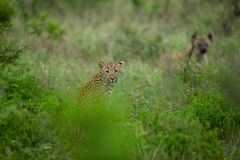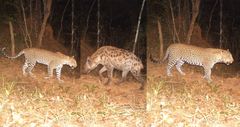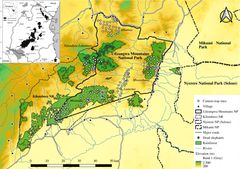Spotted apex predator being pressured by spotted pack hunters – and it's our fault
Leopards, who are already in decline, can’t keep up with hyenas when people are around. As we humans move into the their territories more and more, we are helping to disturb and unbalance ecosystems. This has been shown in a new University of Copenhagen study where researchers used camera traps to observe both large carnivore species.
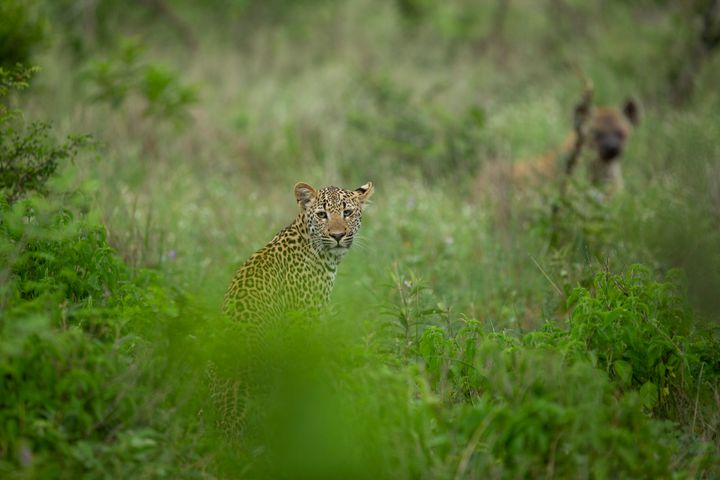
Who’s stronger? A solitary leopard or a cackle of hyenas? And which is best at getting along with humans?
University of Copenhagen researchers closely studied this in a large East African natural area surrounded by rural settlements. The study demonstrates that the presence of humans has a direct impact on the competitive relationship between the two large predator species: leopards (Panthera pardus) – the iconic spotted feline and the spotted hyena (Crocuta crocuta) – a kleptoparasite and pack hunter known for its comical appearance and characteristic 'laugh'.
"We humans continue eating our way into the little bit of wilderness left in the world. As we do, we impact wildlife. This study demonstrates that human disturbance upsets the balance between competing species and that this advantages hyenas," says Rasmus W. Havmøller, the study’s first author and a postdoc at the University of Copenhagen’s Natural History Museum of Denmark.
For months, Havmøller have been using camera traps to observe the dynamics between hyenas and leopards living in Tanzania’s Udzungwa Mountains – an approximately 2,000 km2 national park that is completely surrounded by agricultural and populated areas. The study is the first to combine camera observations of large predators over both time and space in a single analysis.
While the hyena as a species seems to be increasing in numbers, the population of leopards has been in significant decline for decades, both in Africa and worldwide. Since hyenas are the leopards' only competitor in this particular natural area, the ability of the two species to coexist is important for their survival. And here, the local population is an important factor:
"As the local people definitely don’t' like leopards, the leopards retreat as far away from humans as possible. Hyenas, on the other hand, benefit from the fact that humans don’t feel threatened by or pursue them. Consequently, hyenas live in close to human populations and may even exploit humans as shields against the leopards," says Havmøller.
"But the areas nearest to humans are also the areas with the most prey. And as hyenas assert dominance over these areas, it increases their ability to outcompete leopards and potentially threaten the leopard's adaptability," adds Havmøller.
Size matters
The researchers' observations confirm that size matters. While male leopards, which are larger, retain their dominance over hyenas, the situation is different for female leopards, which are smaller.
"Even though the male leopards are the ones in charge, the hyenas aren’t exactly scared off by them. They simply hang out in the background – probably to follow the leopards and steal their prey. But the physical inferiority of the hyenas seems to be compensated for in the areas closest to humans, because male leopards pull out," says Rasmus W. Havmøller, who continues:
"Female leopards, on the other hand, completely change their behavior when hyenas are in the area. They become diurnal, whereas hyenas are primarily nocturnal. This is probably because female leopards are smaller than hyenas, and that they will likely lose in any fight over prey."
Overall, the study shows that the hyenas benefit from living near humans.
"This suggests that the hyena's ability to adapt to areas of human activity may strengthen their overall success as a species and their competitive advantage over other large predators as we humans disturb more and more nature," says Havmøller.
When leopards are pressured, cascade effects may follow
According to the researcher, the shift in female leopard hunting patterns may have negative consequences:
"If you open up for more tourism and build more roads in the national park, the female leopards will be pressured immediately. They aren’t able to differentiate between safari tourists – who are most active during the day – and poachers. In time, they will probably learn that safari guests aren’t dangerous. But if there is a large and rapid influx into the area, you will probably see a decline in their population," says Rasmus W. Havmøller.
If leopards are seriously pressured out of the food chain, one should expect the emergence of what are known as cascade effects in the ecosystem:
"Plucking a large predator like leopards out of a food chain, which can be the ultimate consequence of human disturbances, may have very violent effects. Populations of other species, such as certain monkeys, whose populations are kept in check by leopards, will suddenly become too large and change the balance of the entire ecosystem," says the researcher.
As such, Havmøller hopes that the study will serve to encourage restraint when it comes to managing wilderness areas.
"Our results clearly indicate that human disturbances can change the competitive relationship between important predators. So, I hope that considerations will be made when expanding activities in wilderness areas, so as to roll them out slowly and give animals a chance to adapt. Furthermore, it would be good if the effects of human disturbances were monitored in more places using camera traps," concludes Rasmus W. Havmøller.
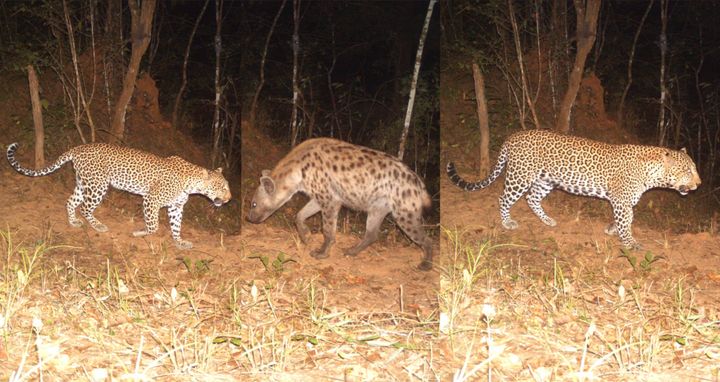
HYENAS VS. LEOPARDS
- Leopards are unpopular among local people in many places because they may hunt livestock and attack humans. Hyenas, on the other hand, "clean up" by eating sick or dead livestock and don’t pose a problem for humans.
- Female leopards (approx. 20-43 kg.) are about half the size of male leopards (approx. 51-72 kg). Hyenas are in the middle in terms of weight (approx. 48-56 kg).
- Leopards are solitary hunters, whereas hyenas hunt in large cackles (clans), which can be an advantage for hyenas in confrontations with leopards.
- Hyenas are kleptoparasites that regularly steal the prey of other carnivores – including leopards.
- Leopards on the other hand, are masterful tree-climbers, which allows them to protect their prey from hyenas.
ABOUT THE STUDY
- The researchers behind the study are: Rasmus W. Havmøller and Linnea W. Havmøller from the Natural History Museum of Denmark, University of Copenhagen; Arielle W. Parsons from Lincoln Park Zoo, USA and Roland Kays from North Carolina State University, USA.
- The study has been published in the scientific journal Ecosphere.
- The research is supported by the ERC under the EU’s Horizon 2020 programme.
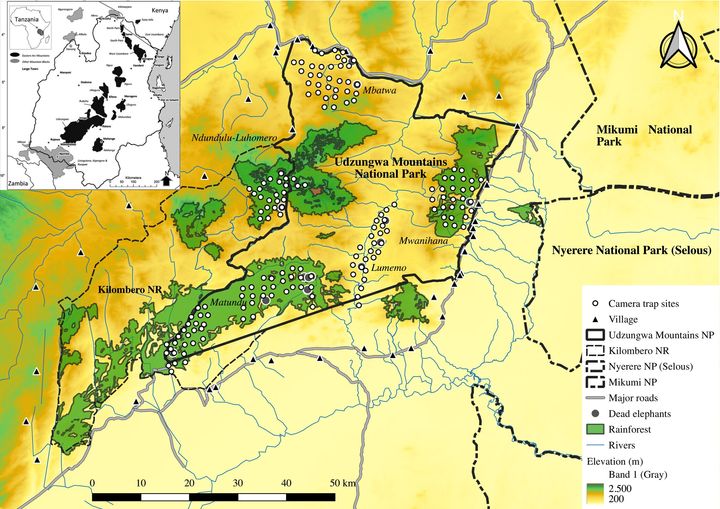
Keywords
Contacts
Rasmus W. Havmøller
Postdoc
Natural History Museum of Denmark
University of Copenhagen
rasmus.havmoeller@snm.ku.dk
+45 35 32 14 59 / +45 22 41 04 31
Maria Hornbek
Journalist
Faculty of Science
University of Copenhagen
maho@science.ku.dk
+45 22 95 42 83
Images
Links
ABOUT THE FACULTY OF SCIENCE
The Faculty of Science at the University of Copenhagen – or SCIENCE – is Denmark's largest science research and education institution.
The Faculty's most important task is to contribute to solving the major challenges facing the rapidly changing world with increased pressure on, among other things, natural resources and significant climate change, both nationally and globally.
Subscribe to releases from Københavns Universitet - Det Natur- og Biovidenskabelige Fakultet
Subscribe to all the latest releases from Københavns Universitet - Det Natur- og Biovidenskabelige Fakultet by registering your e-mail address below. You can unsubscribe at any time.
Latest releases from Københavns Universitet - Det Natur- og Biovidenskabelige Fakultet
Old aerial photos give scientists a new tool to predict sea level rise3.7.2025 08:00:00 CEST | Press release
Researchers from the University of Copenhagen have gained unique insight into the mechanisms behind the collapse of Antarctic ice shelves, which are crucial for sea level rise in the Northern Hemisphere. The discovery of old aerial photos has provided an unparalleled dataset that can improve predictions of sea level rise and how we should prioritise coastal protection and other forms of climate adaptation.
Gamle luftfotos giver forskere nyt redskab til at forudsige havstigninger3.7.2025 08:00:00 CEST | Pressemeddelelse
Forskere fra Københavns Universitet har fået unik adgang til at forstå mekanismerne bag antarktiske ishylders kollaps, som er afgørende for havstigninger på den nordlige halvkugle. Et fund af gamle luftfotos har skabt et enestående datasæt, som kan forbedre vores forudsigelser af hvor meget havene stiger, og vores prioritering af kystsikring og andre klimatilpasninger.
Ny institutleder på IFRO: ”Faglighed og fællesskab går hånd i hånd”1.7.2025 10:49:17 CEST | Pressemeddelelse
Per Svejstrup er fra 1. august ansat som institutleder på Institut for Fødevare- og Ressourceøkonomi (IFRO). Den kommende leder træder ind i rollen med stor respekt for IFRO's faglige og kollegiale kultur med klare ambitioner for fremtiden.
Dangerous Variant of Salmonella Still Not Eradicated – Researchers Point to the Solutions1.7.2025 09:53:23 CEST | Press release
The infectious and multi-resistant cattle disease Salmonella Dublin can be fatal to both humans and animals and causes significant losses for farmers. Although Denmark has attempted to eradicate the disease since 2008, it has not yet succeeded. A study from the University of Copenhagen points to possible reasons – and the necessary solutions.
Farlig type salmonella er stadig ikke nedkæmpet i Danmark – forskere peger på løsningerne30.6.2025 09:54:03 CEST | Pressemeddelelse
Den smitsomme og multiresistente kvægsygdom Salmonella Dublin kan være dødelig for både mennesker og dyr og medfører desuden betydelige tab for landmændene. Selvom Danmark har forsøgt at udrydde sygdommen siden 2008, er det ikke lykkedes. Et studie fra Københavns Universitet peger på den mulige årsag og de nødvendige løsninger.
In our pressroom you can read all our latest releases, find our press contacts, images, documents and other relevant information about us.
Visit our pressroom
